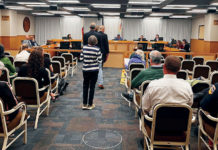
WATSONVILLE—A pair of large housing developments in Watsonville—responsible for 237 units combined—are stuck in limbo.
Hillcrest Estates, formerly Sunshine Vista, and Pacific Sunshine Garden have run into unexpected snags over the past months that have created serious doubts as to whether either will be completed.
The 11-acre former junkyard off Ohlone Parkway where California Sunshine Development LLC planned to build 150 housing units was posted on LoopNet—an online marketplace for commercial property—in late November. But developer Lisa Li told this newspaper that the lot is not for sale, and that she is simply looking for a business partner to help her carry the project to completion.
The development was approved by the city council in August 2018 despite backlash from the surrounding community.
Watsonville City Manager Matt Huffaker said the LoopNet listing caught the city off guard.
“We have concerns about the future of that project,” he said.
Li said Hillcrest Estates has “significantly” surpassed its initial $60 million price tag because of the high cost of labor and materials, but could not say how much additional funding the project would need to be completed.
Li also said funding from foreign investors using the EB-5 Immigrant Investor Visa Program, a previously deep well of cash, has recently dried up because of changes in policy. She said her project did have “some” EB-5 funding, but declined to say how much.
The EB-5 visa program, created by Congress in 1990, provides a path toward permanent residency for foreign nationals—and their immediate family—who invest cash to finance a business in the U.S.
On Nov. 21 the program underwent its first massive overhaul in decades. Two of the biggest changes came in the amount of money investors had to fork over, and which areas qualify as so-called Targeted Employment Areas (TEA), which are rural regions with high unemployment rates. Investing money into developments in TEA’s gave the investor a large financial discount, making it easier for foreigners to receive their green cards and providing U.S. developers with a steady flow of funding for their projects.
Previously, EB-5 petitioners had to invest $500,000 into a project located in a TEA but that number jumped to $900,000 in November. Investments for projects outside of a TEA escalated from $1 million to $1.8 million.
In the past, state and local governments were able to determine whether an area qualified as a TEA. Now, only United States Citizenship and Immigration Services can make that determination. That change, according to the USCIS, was to address gerrymandering of high-unemployment areas. Developers looking to build in affluent neighborhoods would combine a series of census tracts to link a prosperous area to one in distress in order to qualify as a TEA.
Huffaker said the California Sunshine Regional Center, an EB-5 investment manager sanctioned by USCIS and run by Li, submitted the original TEA application in 2011. The city agreed to support its claim so long as it listed several specific city projects in its application, including the Manabe-Ow properties, the location of the 194,000-square-foot FedEx facility in the city’s outskirts.
USCIS officials could not say whether the city qualified as a TEA under the new rules, as the agency processes each claim on a case-by-case basis.
Li added that the processing time for some prospective EB-5 visa investors has ballooned from its typical 31-52 months to a decade-long wait, a claim that USCIS officials supported. Chinese nationals face a 16-year wait, Charles Oppenheim, chief of the State Department’s Immigrant Visa Control & Reporting Division, said at a conference hosted by an EB-5 advocacy group earlier this year.
There are more than 34,000 applicants in line for the roughly 10,000 EB-5 visas made available each year, according to Oppenheim. That’s not including the roughly 39,000 applicants who are still awaiting approval.
“EB-5 market is not favorable to investors anymore,” Li said.
Huffaker also said the city is concerned about the feasibility of the 87-unit Pacific Sunshine Garden, which is just a stone’s throw away from Hillcrest Estates at a 6.8-acre lot on Santa Victoria Avenue.
The $35 million project, which had its groundbreaking in 2016, has stalled because of numerous building code infractions, Assistant Community Development Director/Building Official Rob Allen said.
According to more than 300 pages of city documents, the project has been plagued by violations since 2017, when it used an unpermitted crew to install gas lines. Since then, city building inspectors have issued dozens of correction notices to fix the faults, which include cracked foundations and faulty framing due to overexposure to the elements. A majority of those correction notices went unanswered, forcing Allen to completely halt the project last month.
“I’m not going to allow residents to live in unsafe housing,” Allen said. “I can’t do that.”
Allen said the developer has hired a remediation contractor to fix the deficiencies but does not expect construction to pick back up any time soon.
Though multiple media reports from its groundbreaking and a USCIS document from 2016 say the project was at least initially funded by EB-5 investors, sales manager David Wang of Century 21 said the project has not taken “one cent” from the program.
“Maybe initially they thought they would need the funding but that isn’t the case anymore,” he said. “Funding is not a problem.”
The loss of those two projects would be a huge blow to Watsonville, which is struggling to keep up with an ever-growing demand for housing—especially of the affordable variety. Together they would add 47 affordable units, the majority of which, according to initial media reports, were going to be for South County residents.
Huffaker said if those projects do fall through the city would continue to pursue housing projects at those locations through other developers.
“I think both of those sites are viable for housing and that’s the city council’s top priority at the moment,” Huffaker said.
The loss of those developments could also be a big financial loss for the Pajaro Valley Unified School District, which is currently facing steadily declining student enrollment.
The district lost roughly 350 students after the last school year because of the high cost of housing in the Central Coast and the addition of a charter school, Watsonville Prep, which took nearly 200 students from the district’s public schools and will strip away an additional 57 each year until it reaches its 420-student cap in 2023.
That loss of students equates to an annual revenue loss of about $670,000, PVUSD Chief Business Officer Joe Dominguez said at last week’s district meeting.
In a prepared statement, PVUSD said it does not “stand to lose anything” if those developments are not completed.
“PVUSD had not taken into account any increases for the 2019-20 [budget] from these two developments currently on hold,” the statement said.












